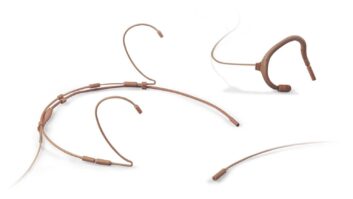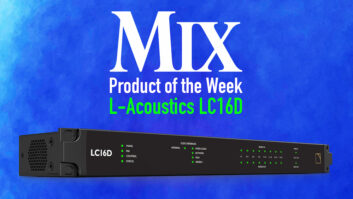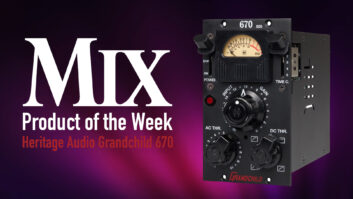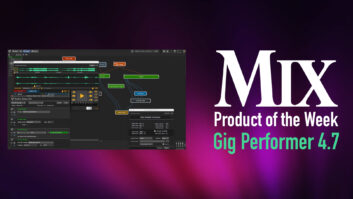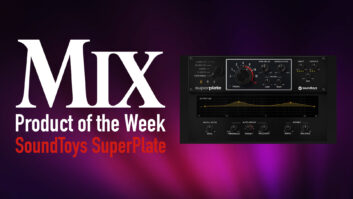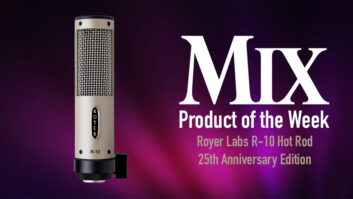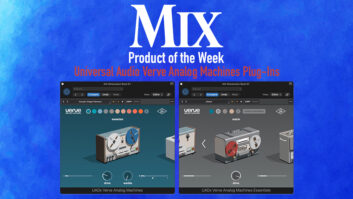Okay, I know what you’re going to say. “This is Mix. You’re focused on pro audio. What are you doing covering a $99 large-diaphragm cardioid condenser mic aimed primarily at podcasters and YouTubers?” Well, I must admit to having had similar thoughts myself. But, I was sent a review unit and figured I might as well check it out. Blue does make a lot of great mics, so why not give it a try?
After testing the Blue Microphones Ember on a bunch of instruments and vocals, I concluded that it was definitely deserving of coverage here. Put simply: It sounds great. Yes, I know, it’s a $99 mic. It can’t possibly sound great—yet somehow it does. Makes me wonder what kind of voodoo (or perhaps it’s “hoodoo”) Blue put on it.
But I’m getting ahead of myself. I’ll start from the beginning. I opened the shipping box containing the review unit Blue sent, and inside found an elegant, dark-gray box with the company’s logo embossed on it. I opened the box and noticed a little illustration printed on the back flap showing how to address a side-address mic “Your voice goes here,” was printed on it with a little arrow pointing the side of the capsule. Another arrow pointed to the top of the mic and said, “Not here.”
At that point, I wasn’t brimming with confidence about sound quality. The mic was clearly aimed primarily at people with little or no recording experience.
Read more Product of the Week: Audient ID44 Audio Interface.
I took the mic out of the box and noticed that it’s not completely cylindrical; the body is a little wider than it is deep. In any case, it’s quite spiffy-looking. Blue has the industrial-design thing totally down. It’s dark gray in color with a shiny metal grille at the top. It comes with an unremarkable, but functional, stand mount.
I was still thinking, “podcast mic,” until I plugged it in and tried recording acoustic guitar. “Hmm. Sounds surprisingly nice.” It was bright in a non-harsh way and captured the vibe and transients of the acoustic. I tried fingerpicking, flatpicking, strumming, you name it, and all sounded excellent through the Ember. (In case you’re wondering, the mic was connected to my DAW through one of the mic inputs of my RME Fireface 802, which are pretty transparent, allowing me to hear the sound of the mic without coloration.)
I also tried it with vocals. I recorded a new version of a lead vocal I’d tracked with a much more expensive vocal mic a few weeks ago. I compared the two and was pleased at how open and clear the Ember-version sounded. It must have a presence boost of some sort because everything I recorded through it sounded bright—in a good way. I looked at the manual for a frequency graph, but couldn’t find one.
I then tried recording some spoken word material into it, and, again was impressed with the clarity. I noticed the cardioid pattern was pretty tight, and there was a lot of off-axis rejection. It’s definitely better to stay right in front of it. I also found its low-end response was a bit lacking, although when I got right up on it and took advantage of the proximity effect, it sounded pretty big.
Onward. I recorded an acoustic-guitar slide part. Over the years, I’ve found those types of parts are tricky to get a good sound on. With the Ember, I was pleasantly surprised. It was warm and upfront and captured the nuances really well.
Then I tried recording a Dobro (a square-neck model, played flat on my lap with a bar-type slide). Same result. Again, maybe not as fat on the bottom as some other mics I use for that instrument, but warm and clean on the top. It also nicely reproduced the midrange, which is where a lot of a Dobro’s tone resides.
Next, I tried a mandolin. It was present and bright (again, not too bright) and sounded fantastic (despite my limited chops). Often with condenser mics, I’ve found this particular mandolin to sound a little harsh, but through the Ember, it was warm and detailed, with crisp transients.
At that point, I had to move onto some other work, so I walked away from my studio for an hour or so. When I returned, I listened to the tests again, half expecting that given a little space, I’d now notice all the flaws. But that didn’t happen. If anything, I was more impressed. I also listened again the next morning, and my positive opinion was unchanged. Again, I wondered, how could this be a $99 mic?
I don’t know the answer to that, but wow. When it comes to value, Ember is off the charts. Blue has captured lightning in a…well, I was going to say a “bottle,” but that might be confused with another Blue mic model. But there was no confusion about Ember— it’s way more than a podcast mic.
